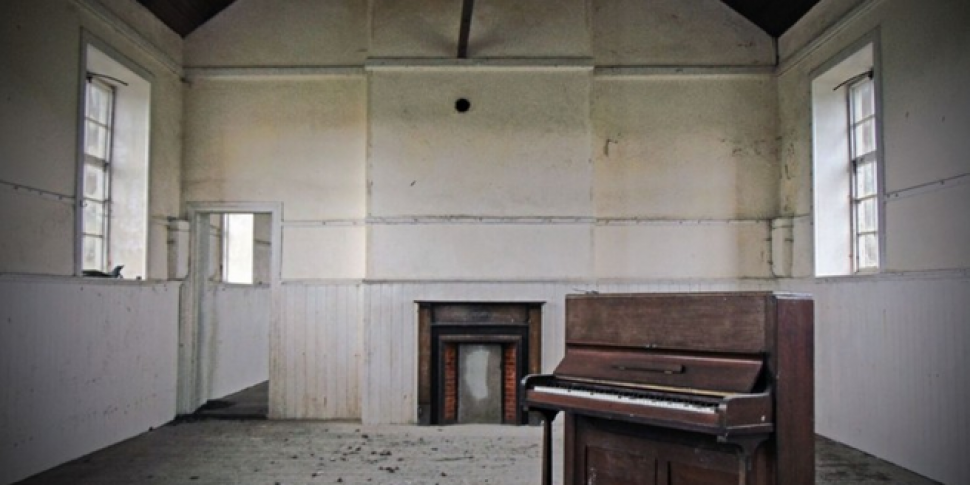While the last place anybody wants to go to at weekends in school, for archaeologist and photographer Enda O’Flaherty, it’s a labour of love. It’s also a labour of loss, documenting, as he does, how Ireland’s ever-changing demographics, altered over decades by years of emigration to the world beyond our shores, has changed the country’s network of school buildings. In the last year, O’Flaherty has taken himself and his camera around Ireland, calling in on nearly 150 derelict and abandoned school houses. What were once centres of youth and learning are now decaying relics of a not-too-distant past.
Many of the structures, now standing in ruins, comprised one or two-roomed school houses, dotted all over the island of Ireland and catering to even the most rural of communities in a time before school buses and parents ferried children around in the morning rush. For the thousands of children who went through those rooms, many of whom likely emigrated to make their fortunes elsewhere, these tiny buildings might well have been the place where they last any had kind of formal education before leaving everything they knew to make a new home elsewhere.
While the school houses have borne the brunt of abandonment by falling into serious disrepair, they still form an important part in the design and construction history of Ireland. Many of the buildings O’Flaherty has visited are included in the National Inventory of Architectural Heritage, the state initiative that identifies, records, and evaluates the post-1700 architectural heritage of Ireland. But many more of the school houses are not recognises on this list, belying the significance they undoubtedly once played in the most rural communities and isolated townlands in Ireland.
Over on his blog, O’Flaherty captures a sense of what has been lost to time and ruination, documenting with his camera lens the destruction of the structure, but also the sense these spaces were once classrooms where the future of Ireland made their first steps in learning what they needed to shape the country as we know it. The archaeologist is now gathering images and stories surrounding the school houses in a book, which he hopes to publish in 2017.
“Contemporary ruins can provoke an unusual emotional response that is difficult to define,” O’Flaherty says. “A familiar environment that has fallen into decay can be both unsettling and intriguing, inspiring fascination and fear as a tangible reminder of the scale of your own lifetime.”
Ballymakeehola National School, Co Mayo

"This rural two-roomed national school is situated in the sparsely populated and boggy townland of Ballymackeehola in north-west Mayo. With little tree cover, the area is often wind-swept, with the Atlantic Ocean sometimes bringing a damp and harsh gale. The plaque above the doorway dates the construction of the school to 1895.
"It remained in use until 1969."
Bunnadeen, Co Sligo (1883)

"A plaque on the northern end of the building dates its construction to 1883 although the First Edition Ordnance Survey sheet above shows that there was a pre-existing school at this site in at least the 1840s . Although in ruin, the interior is relatively well preserved, with the brightly painted walls having a now spooky patina."
Whiddy Island National School, Co Cork (1887)

"Whiddy Island is a small, near-shore island located at the head of Bantry Bay in Co Cork. Not far from the modern quayside and in the townland of Trawnahaha is a small late 19th-century one-roomed school house overlooking Bantry Bay below. Painted bright blue with a white lime-wash, in recent years the building had been used as a local museum though it has now fallen into a state of disrepair."
Carrigan National School, Co Cavan (1897)

"The building includes the typical double entrances at each end for boys and girls, with the schoolyard to the rear also being segrated. A Stone plaque to centre of front elevation is inscribed ‘CARRIGANS NATIONAL SCHOOL / 1897 / ENLARGED BY REV T. MAGUIRE CC / 1929’"
Gortahouse, Co Leitrim (1890)

"In 1937 the Irish Folklore Commission, in collaboration with the Department of Education and the Irish National Teachers’ Organisation, initiated a revolutionary scheme in which schoolchildren were encouraged to collect and document folklore and local history. Over a period of eighteen months some 100,000 children in 5,000 primary schools in the twenty-six counties of the Irish Free State were encouraged to collect folklore material in their home districts. This of course included Gortahose."
Latton National School, Co Monaghan (1941)

"Now standing in open pasture, the structure is gradually giving way to the elements. To the front of the building there is an inscribed limestone date and name plaque reading ‘Scoil Mhuire Leacht Fhinn Scoil Náisiúnta 1941’. However, inside many of the fixtures and fittings remain, and each classroom retains much of the original furniture giving the environment a particularly spooky feeling."
Shanavaghera, Co Mayo (1935)

"The building is certainly in a ruinous state, with nature making its way in through the shattered glass and broken doorways. Nonetheless, original features such as the wooden partition that divided the main room into three classrooms, three original fireplaces, and a single school desk added wonderful atmosphere to this building. The separate entrances for boys and girls are to the rear of the school, and the numbered coat-hooks once used by the pupils can be seen in the entrance hall. The suspended wooden floor remains solid enough to walk on without fear of it collapsing beneath your feet."
Enda O'Flaherty continues to catalogue and photograph Irish school houses and his new book will feature extracts taken from the Irish school children's records held by the Irish Folklore Commission since the 1930s.
To keep up to date with his work and to see new images, or to make a suggestion of a school house to visit, please visit his blog or find him on Facebook and Twitter.









